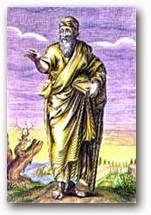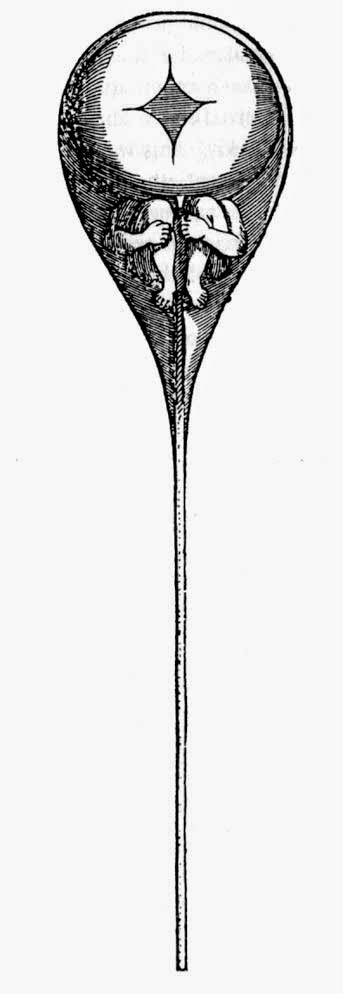الاسلام يسبق العلم ب 13 قرن بيولوجيا
القرأن الكريم يخبرنا بأن الجنين يتكون من الذكر والانثى
حيث يقول الله فى كتابة العزيز
{يَا أَيُّهَا النَّاسُ إِنَّا خَلَقْنَاكُم مِّن ذَكَرٍ وَأُنثَى وَجَعَلْنَاكُمْ شُعُوباً وَقَبَائِلَ لِتَعَارَفُوا إِنَّ أَكْرَمَكُمْ عِندَ اللَّهِ أَتْقَاكُمْ إِنَّ اللَّهَ عَلِيمٌ خَبِيرٌ }الحجرات13
كما ترى عزيزى فان القرأن يقر بان الجنين ناتج من الذكر والانثى يعنى ان كلاهما مشترك فى تكوين الجنين
بس ايه الغريب فى الموضوع ما كل البيولوجين عارفين الموضوع دة
يعنى انت مثلا لو سألتنى السؤال دة
مما يتكون الجنين ؟؟؟؟؟؟؟؟؟؟؟؟؟؟؟؟
سؤال يبدوا من الوهلة الاولى انه سؤال بسيط جدا
واجابتة ابسط من البساطة يتكون الزيجوت من اتحاد نواة الحيوان المنوى وبنواة البويضة , ومصدر السيتوبلازم يكون سيتوبلازم البويضة
معقول يعنى انا كاتب موضوع وتاعب نفسى عشان اكتب السؤال البسيط دة وارد عليه وخلص الموضوع
طيب ما اى بيولوجى فى العالم عارف رد السؤال دة
ايه الجديد فى الموضوع ؟؟؟؟؟؟؟؟؟؟؟؟؟؟؟؟
المفاجئة هنا هل حقا كان كل بيولوجين العالم يعرفون ان الزيجوت ناتج من اتحاد حيوان منوى ببويضة ام ان البيولوجين لم يكونوا يعرفوا هذه المعلومة ؟؟؟؟؟؟؟؟؟؟؟؟؟؟؟؟؟؟؟
المفاجئة بقى ان البيولوجين لم يكن يعرفوا هذه المعلومة الا فى اواخر القرن التاسع عشر
لا تتعجب عزيزى فساسرد لك كل اراء العلماء فى هذا الصدد وستندهش لكن تابع معى
اثناء سردى لاراء البيولوجين حول تكون الجنين فانى اسرد ارائهم طبقا لعدة نظريات
1- نظرية البخار Vapour Theory
اعتقد علماء الاغريق القدماء منذ حوالى 500 عام قبل الميلاد ان جميع اعضاء الكائن الحى تنتج نوعا من الابخرة تتكثف الى سوائل تحدد صفات الابناء وقد تبنى هذا الرأى ايضا فيثاغورث

2- نظرية السوائل Fluid Theory
ان جميع اعضاء الكائن الحى تنتج نوعا من الابخرة تتكثف الى سوائل تحدد صفات الابناء اضاف الفليسوف اليونانى الشهير ارسطو الى هذا الاعتقاد جزئية جديدة مفادها ان السائل المنوى للرجل تتجمع فيه هذه السوائل التى اطلق عليها مادة الحياة وهى فى رائيه الدم فى انقى صوره , تتجمع لتكون الجنين الجديد اما النساء فلا دخل لهن فى تحديد صفات الجنين بل يعملن كحضانات فقط توفر لهذه الاجنة المأوى والغذاء فى ارحامهن
ثم غير ارسطو رائيه بعد ذلك مدعيا
(( ان دم الحيض للاناث يتحد مع منى الذكر فيتكون الجنين ))

3- نظريات سبق التكوين Preformation Theories

وفى هذه النظرية يوجد رائيين مختلفين
اما ان الانسان يوجد متقزما داخل الحيوان المنوى او داخل البويضة
فأنصار المدرسة البيضية Ovists يعتبرون ان الانسان يوجد بالكامل داخل البويضة ولا دخل للحيون المنوى بتكوين الجنين , وان البويضة فقط هى التى تحتوى على الحياة وهى التى تحتوى على مادة التوراث , انما دور الحيوان المنوى فقط هو دور منبة لبدء نمو البويضة
ومن انصار المدرسة البيضية كل من

1_ أول من درس جنين الدجاجة باستخدام عدسة بسيطة هو هارفي Harvey عام 1651, ودرس كذلك جنين الأيل Deerولصعوبة معاينة المراحل الأولى للحمل استنتج أن الأجنة ليست إلا إفرازات رحمية

2_ وفي عام 1672 اكتشف جراف Graaf حويصلات في المبايض ما زالت تسمى باسمه Graafian Folliclesوعاين حجيرات في أرحام الأرانب الحوامل تماثلها فاستنتج أن الأجنة إفرازات من المبايض, ولم تكن تلك التكوينات الدقيقة سوى تجاويف في كتل الخلايا الجنينية الأوليةBlastocysts
3_ وفي عام 1675 عاين مالبيجي Malpighi أجنة في بيض دجاج ظنه غير محتاج لعناصر تخصيب من الذكر واعتقد أنه يحتوى على كائن مصغر ينمو ولا يتخلق في أطوار
4_ بينما تمكن شفامردام فى هولندا من تمييز بيض الحشرات اكبر كثيرا فى الحجم وادعى انه بيض الحشرات لا يحتاج تخصيب من الذكر
فى حين ذهب انصار المدرسة الحيوانية animalculistsالى عكس ذلك

حيث ادعى انصار هذه المدرسة الى ان الانسان يوجد قزما داخل الحيوان المنوى وان الحيوان المنوى فقط هو من يحمل الحياة وان الحيوان المنوى فقط هو الذى يحمل المادة الوراثية
فقد ادعى هذا الادعاء كل من هام Hamm وليفنهوكLeeuwenhoek عام 1677

ايضا اعتقد العالم الهولندى سوامردوم Swammerdum فى اوائل القرن الثامن عشر ان الحيونات المنوية تحتوى على جنين مصغر تام التكوين اطلق عليه اسم الانيسHomunculas
4- نظرية الصندقة Encapsulation Theory
ادعى عالم الاحياء السويسرى بونية Bonnet 1720 – 1793ان الانثى تحتوى على كل الوحدات التوالدية لجميع نسلها القريب والبعيد بحيث يحتوى كل جيل جميع الاجيال التى تليه , وبمعنى اخر ان امنا حواء كانت تختزن فى مبيضها الوحدات التوالدية لجميع افراد الانسان كالصناديق المتدرجة الحجوم كل منها داخل الذى يسبقه فى الحجم
وقد تبنى رأى بونية ايضا الفلسوف لايبنتز Leibnitz قائلا ان الله سبحانه وتعالى اتم تكوين كل شئ يوم الخليقة وان جميع الكائنات مقدرة منذ البداية
القرأن الكريم يخبرنا بأن الجنين يتكون من الذكر والانثى
حيث يقول الله فى كتابة العزيز
{يَا أَيُّهَا النَّاسُ إِنَّا خَلَقْنَاكُم مِّن ذَكَرٍ وَأُنثَى وَجَعَلْنَاكُمْ شُعُوباً وَقَبَائِلَ لِتَعَارَفُوا إِنَّ أَكْرَمَكُمْ عِندَ اللَّهِ أَتْقَاكُمْ إِنَّ اللَّهَ عَلِيمٌ خَبِيرٌ }الحجرات13
كما ترى عزيزى فان القرأن يقر بان الجنين ناتج من الذكر والانثى يعنى ان كلاهما مشترك فى تكوين الجنين
بس ايه الغريب فى الموضوع ما كل البيولوجين عارفين الموضوع دة
يعنى انت مثلا لو سألتنى السؤال دة
مما يتكون الجنين ؟؟؟؟؟؟؟؟؟؟؟؟؟؟؟؟
سؤال يبدوا من الوهلة الاولى انه سؤال بسيط جدا
واجابتة ابسط من البساطة يتكون الزيجوت من اتحاد نواة الحيوان المنوى وبنواة البويضة , ومصدر السيتوبلازم يكون سيتوبلازم البويضة
معقول يعنى انا كاتب موضوع وتاعب نفسى عشان اكتب السؤال البسيط دة وارد عليه وخلص الموضوع
طيب ما اى بيولوجى فى العالم عارف رد السؤال دة
ايه الجديد فى الموضوع ؟؟؟؟؟؟؟؟؟؟؟؟؟؟؟؟
المفاجئة هنا هل حقا كان كل بيولوجين العالم يعرفون ان الزيجوت ناتج من اتحاد حيوان منوى ببويضة ام ان البيولوجين لم يكونوا يعرفوا هذه المعلومة ؟؟؟؟؟؟؟؟؟؟؟؟؟؟؟؟؟؟؟
المفاجئة بقى ان البيولوجين لم يكن يعرفوا هذه المعلومة الا فى اواخر القرن التاسع عشر
لا تتعجب عزيزى فساسرد لك كل اراء العلماء فى هذا الصدد وستندهش لكن تابع معى
اثناء سردى لاراء البيولوجين حول تكون الجنين فانى اسرد ارائهم طبقا لعدة نظريات
1- نظرية البخار Vapour Theory
اعتقد علماء الاغريق القدماء منذ حوالى 500 عام قبل الميلاد ان جميع اعضاء الكائن الحى تنتج نوعا من الابخرة تتكثف الى سوائل تحدد صفات الابناء وقد تبنى هذا الرأى ايضا فيثاغورث

2- نظرية السوائل Fluid Theory
ان جميع اعضاء الكائن الحى تنتج نوعا من الابخرة تتكثف الى سوائل تحدد صفات الابناء اضاف الفليسوف اليونانى الشهير ارسطو الى هذا الاعتقاد جزئية جديدة مفادها ان السائل المنوى للرجل تتجمع فيه هذه السوائل التى اطلق عليها مادة الحياة وهى فى رائيه الدم فى انقى صوره , تتجمع لتكون الجنين الجديد اما النساء فلا دخل لهن فى تحديد صفات الجنين بل يعملن كحضانات فقط توفر لهذه الاجنة المأوى والغذاء فى ارحامهن
ثم غير ارسطو رائيه بعد ذلك مدعيا
(( ان دم الحيض للاناث يتحد مع منى الذكر فيتكون الجنين ))

3- نظريات سبق التكوين Preformation Theories

وفى هذه النظرية يوجد رائيين مختلفين
اما ان الانسان يوجد متقزما داخل الحيوان المنوى او داخل البويضة
فأنصار المدرسة البيضية Ovists يعتبرون ان الانسان يوجد بالكامل داخل البويضة ولا دخل للحيون المنوى بتكوين الجنين , وان البويضة فقط هى التى تحتوى على الحياة وهى التى تحتوى على مادة التوراث , انما دور الحيوان المنوى فقط هو دور منبة لبدء نمو البويضة
ومن انصار المدرسة البيضية كل من
1_ أول من درس جنين الدجاجة باستخدام عدسة بسيطة هو هارفي Harvey عام 1651, ودرس كذلك جنين الأيل Deerولصعوبة معاينة المراحل الأولى للحمل استنتج أن الأجنة ليست إلا إفرازات رحمية

2_ وفي عام 1672 اكتشف جراف Graaf حويصلات في المبايض ما زالت تسمى باسمه Graafian Folliclesوعاين حجيرات في أرحام الأرانب الحوامل تماثلها فاستنتج أن الأجنة إفرازات من المبايض, ولم تكن تلك التكوينات الدقيقة سوى تجاويف في كتل الخلايا الجنينية الأوليةBlastocysts
3_ وفي عام 1675 عاين مالبيجي Malpighi أجنة في بيض دجاج ظنه غير محتاج لعناصر تخصيب من الذكر واعتقد أنه يحتوى على كائن مصغر ينمو ولا يتخلق في أطوار
4_ بينما تمكن شفامردام فى هولندا من تمييز بيض الحشرات اكبر كثيرا فى الحجم وادعى انه بيض الحشرات لا يحتاج تخصيب من الذكر
فى حين ذهب انصار المدرسة الحيوانية animalculistsالى عكس ذلك

حيث ادعى انصار هذه المدرسة الى ان الانسان يوجد قزما داخل الحيوان المنوى وان الحيوان المنوى فقط هو من يحمل الحياة وان الحيوان المنوى فقط هو الذى يحمل المادة الوراثية
فقد ادعى هذا الادعاء كل من هام Hamm وليفنهوكLeeuwenhoek عام 1677

ايضا اعتقد العالم الهولندى سوامردوم Swammerdum فى اوائل القرن الثامن عشر ان الحيونات المنوية تحتوى على جنين مصغر تام التكوين اطلق عليه اسم الانيسHomunculas
4- نظرية الصندقة Encapsulation Theory
ادعى عالم الاحياء السويسرى بونية Bonnet 1720 – 1793ان الانثى تحتوى على كل الوحدات التوالدية لجميع نسلها القريب والبعيد بحيث يحتوى كل جيل جميع الاجيال التى تليه , وبمعنى اخر ان امنا حواء كانت تختزن فى مبيضها الوحدات التوالدية لجميع افراد الانسان كالصناديق المتدرجة الحجوم كل منها داخل الذى يسبقه فى الحجم
وقد تبنى رأى بونية ايضا الفلسوف لايبنتز Leibnitz قائلا ان الله سبحانه وتعالى اتم تكوين كل شئ يوم الخليقة وان جميع الكائنات مقدرة منذ البداية





تعليق